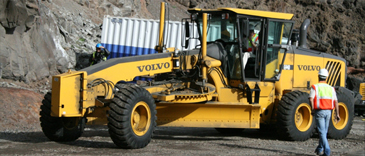A fleet of 46 Volvo machines is being used on the tiny South Atlantic Island of Saint Helena for what is the biggest construction project in the island’s history – the construction of an airport, access roads and supporting infrastructure.
Saint Helena, a British overseas territory, is one of the most remote places in the world lying nearly 2,000km off the coast of Africa. It’s also rich in history. In 1657, England’s Lord Protector, Oliver Cromwell granted the East India Company a charter to govern St. Helena and the following year, the company fortified the island and colonized it. But 350 years later, the population is still small. That could all be about to change.
It’s anticipated that once completed the airport will spur sustainable economic development for the island’s 4,000 residents, with an estimated 20,000 people a year forecasted to visit. At 122km2 the equatorial volcanic outcrop features some very steep terrain. Emphasizing St. Helena’s remoteness is the fact that the island’s only lifeline to the outside world is the RMS St. Helena, an old Royal Mail ship that makes the trip from South Africa just once every three weeks.
Beautiful mountains and sea drops
The project’s client is St Helena’s Government and is being funded by the UK’s Department for International Development (DfID) with the two phases of the project valued at USD $371 million.
The airport is being constructed on an arid part of the island – the Prosperous Plain – an area on the north-eastern coast of Saint Helena. The airport will sit among some imposing but beautiful mountains and 300m drop-offs from the Plain to the sea. Phase One will see the construction of the airport and supporting infrastructure, including a 14km long connecting road to the capital of Jamestown, while Phase Two will see the operation of the airport for a period of 10 years, commencing in February 2016.
When the Saints come marching in
Construction giant Basil Read has been contracted to carry out the work and began by building a temporary rock and concrete jetty in Rupert’s Bay on the North of the island, with mooring points positioned in the bay to enable the safe offloading of materials (there is no existing harbor on the island). The jetty is capable of accommodating the NP Glory 4, Basil Read’s chartered 1,530 tonne (2,111 tonnes when fully loaded) deck cargo ship, which was the first ocean going vessel ever to voluntarily touch the island. (It’s had the odd shipwreck!)
The first machine to drive onto St. Helena was a Volvo Construction Equipment (Volvo CE) G940B motor grader followed by Volvo’s 70 tonne EC700C excavator and several Volvo articulated haulers, including both the new F-Series A40Fs and an A30E. This fleet was joined by smaller machines – an EW140C excavator, BL61B backhoe loader and DD24 compactor – all previously delivered to the island by RMS St. Helena for site preparation work in the Bay.
“In order for workers to get to the island, they are transported on the RMS St Helena from Cape Town on a five-day voyage,” says Jimmy Johnston, project director. “We move our equipment and materials from Walvis Bay in Namibia on our own chartered vessel, which is an 80m long ocean-going-landing-craft that has been fitted with a 40 tonne derrick crane and also modified to carry one million litres of fuel, plus 1,000 tonnes of cargo. The vessel takes just over five days to reach the island from Walvis and about eight days on the return. The current cycle period is around 22 days.”
Once complete the concrete runway will be 1,950m long and the terminal building, air traffic tower and fire station will all be around 2,500m2. Hard at work are four EC700DL excavators, 20 A40F haulers, four A30E hauler-based container carriers, two G940 graders, six A30Es converted to water trucks, two A30E haulers, a EC360B excavator with breaker, a EW140C excavator, four SD200X compactors, a L120F loader and EC290 excavator.
“We chose the Volvo machines because of the price, delivery time and quality – as quality is what Volvo is famous for,” says Roelof Van Der Merwe, equipment director for Basil Read. “The machines are front line equipment and crucial to maintain our schedule. We are very positive and impressed with the machinery. At full production we will be working approximately two 10-hour shifts with four teams. Each team will have a 70 tonne excavator and five 40 tonne haulers plus ancillary machines such as graders, dozers and water trucks. At peak times, we expect to work six days a week.”
Dynamic Volvo Customer Support
Prior to the main equipment landing ashore, Volvo CE’s independent South African dealer, Babcock, had service personnel, technicians and parts personnel already in place on the island. Furthermore, Volvo is backing up this team with a technical supervisor for the project. A second delivery by the freighter NP Glory 4 landed a further 15 Volvo A40F articulated haulers, three additional Volvo EC700C excavators and three SD200DX single drum soil compactors.
 Constructionshows
Constructionshows


